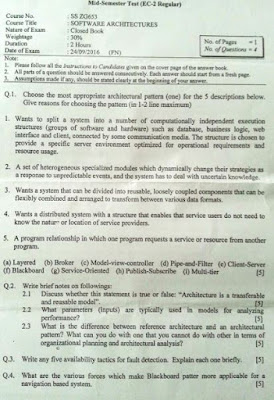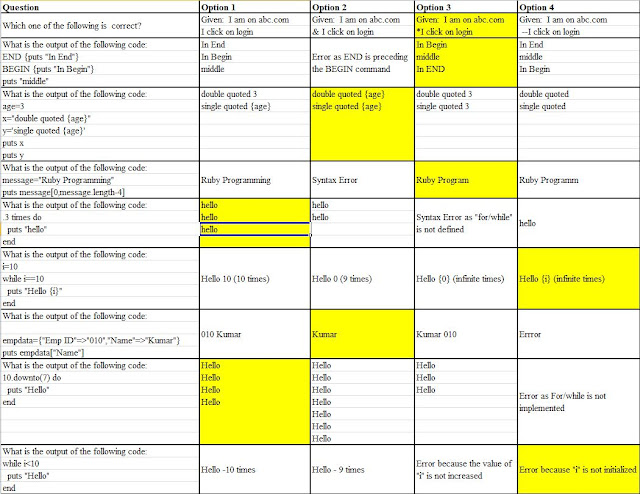Mid-Sem Paper Solutions:
Question:
Q.1 Choose the most appropriate architectural pattern (one) for the 5 descriptions below. Give reasons for choosing the pattern (in 1-2 line maximum)
Question:
Q.1 Choose the most appropriate architectural pattern (one) for the 5 descriptions below. Give reasons for choosing the pattern (in 1-2 line maximum)
1. Wants to split a system into a number of
computationally independent execution structures (groups of software and
hardware) such as database, business logic, web interface and client, connected
by some communication media. The structure is chosen to provide a specific
server environment optimized for operational requirements and resource
usage.
2. A set of heterogeneous specialized modules
which dynamically change their strategies as a response to unpredictable
events, and the system has to deal with uncertain knowledge.
3. Wants a system that can be divided into
reusable, loosely coupled components that can be flexibly combined and arranged
to transform between various data formats.
4. Wants a distributed system with a structure
that enables that service users do not need to know the nature or location of
service providers.
5. A program relationship in which one program
requests a service or resource from another Program.
Nominees:
(a) Layered
(b) Broker
(c) Model-view-controller
(d) Pipe-and-Filter
(e) Client-Server
(f) Blackboard
(g) Service-Oriented
(h) Publish-Subscribe
(i) Map-Reduce
For Practice:
- Wants a system that quickly can analyze enormous volumes of data by sorting the data and then analyzing the grouped data. -> Map-Reduce
- Wants to set up a set of equal distributed computational entities that are connected via a common protocol to share their services and provide high availability and scalability. -> Peer-to-peer
1. Multi-tier
2. Blackboard
3. Pipe-and-Filter
4. Broker
5. Client-Server
Question:
Q.2. Write brief notes on followings:
2.1 Discuss whether this statement is true or false: “Architecture is a transferable and reusable model”.
Answer:
Yes, it is true. Architecture can be created as transferable, reusable model that forms the heart of a product line.
Below is some key-point which does prove the importance of this.
Architecture can provide the basis for evolutionary prototyping.
Architecture is the key artifact that allows the architect and project manager to reason about cost and schedule.
By restricting design alternatives, architecture channels the creativity of developers, reducing design and system complexity.
Architecture defines a set of constraints on subsequent implementation.
2.2 What parameters (inputs) are typically used in models for analyzing performance
Answer:
Parameters (inputs) for analytic modeling of performance (candidates):
Arrival rate of events
queuing discipline
scheduling algorithm
service time for events
network topology
network bandwidth
routing algorithm
2.3 What is the difference between reference architecture and an architectural pattern?
Answer:
An important difference between a pattern and reference
architecture is that a pattern must be a recurrent solution that was already
used on existing implementations. On the other hand, reference architecture can
propose new, innovative solutions in its structure, whose usage was not yet
proven in existing software. As a consequence, reference architecture is more
suitable to propose a structure for new domains, which are not still well
established.
Patterns and reference architectures document
solutions in different levels of granularity. While a pattern focus on a single
problem and in a single recurrent solution, reference architecture usually
considers the target domain as a whole.
Question:
Q.3. Write any five availability tactics for fault detection. Explain each one briefly.
Answer:
Below are the 5 availability tactics for fault detection:
Ping
– Client (or fault-detector) pings the server and gets response back
– To avoid less communication bandwidth- use hierarchy of fault-detectors,
the lowest one shares the same h/w as the server
Heartbeat
– Server periodically sends a signal
– Listeners listen for such heartbeat. Failure of heartbeat means that the server is dead
– Signal can have data (ATM sending the last txn)
Exception Detection
– Adding an Exception handler means error masking
Voting (TMR)
– Three identical copies of a module are connected to a voting system which compares outputs from all the three components. If there is an inconsistency in their outputs when subjected to the same input, the voting system reports error/inconsistency.
– Majority voting, or preferred component wins
Timer and Time-stamping
– If the running process does not reset the timer periodically, the timer triggers off and announces failure
- Time-stamping: assigns a timestamp (can be a count, based on the local clock) with a message in a decentralized message passing system. Used to detect inconsistency.












